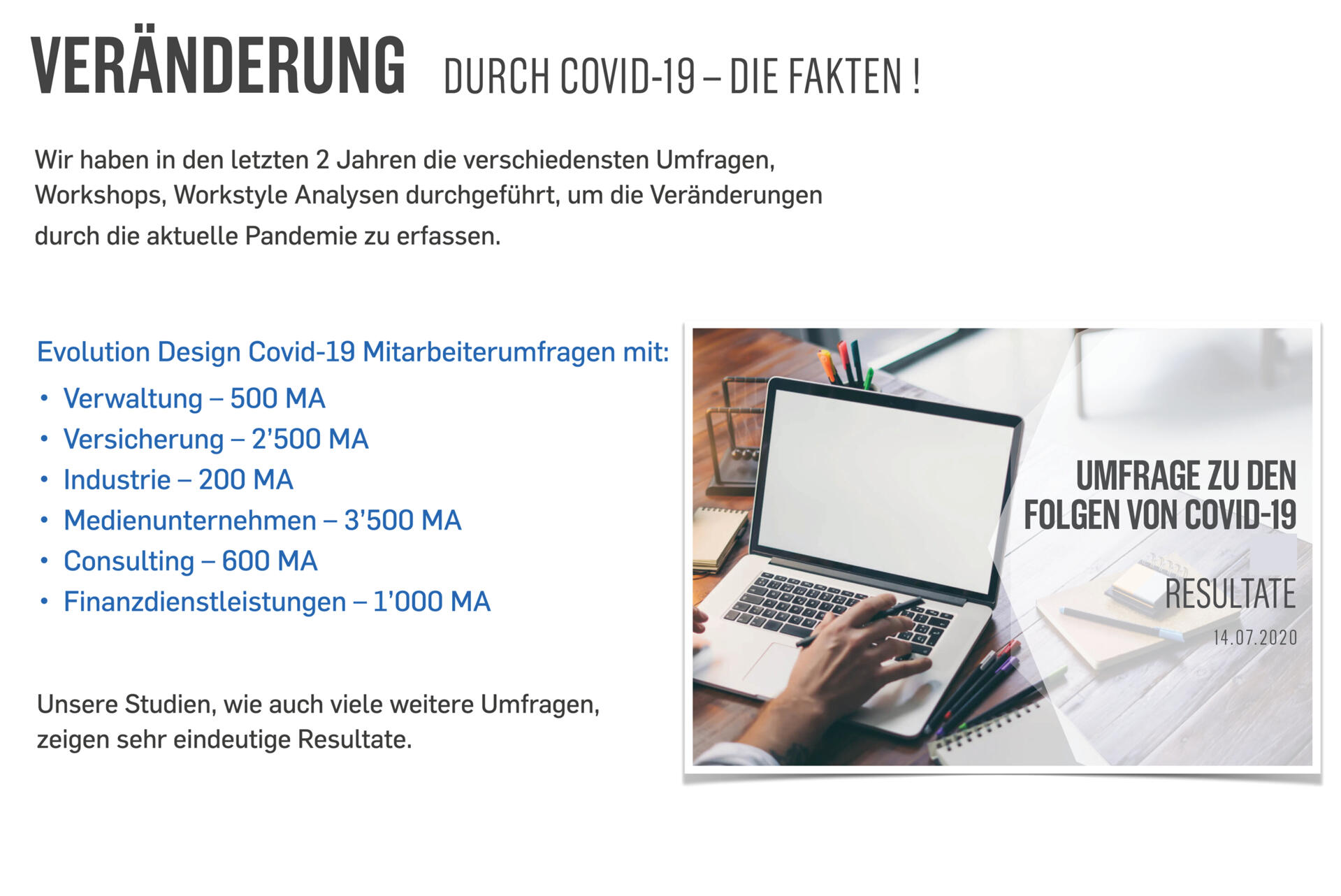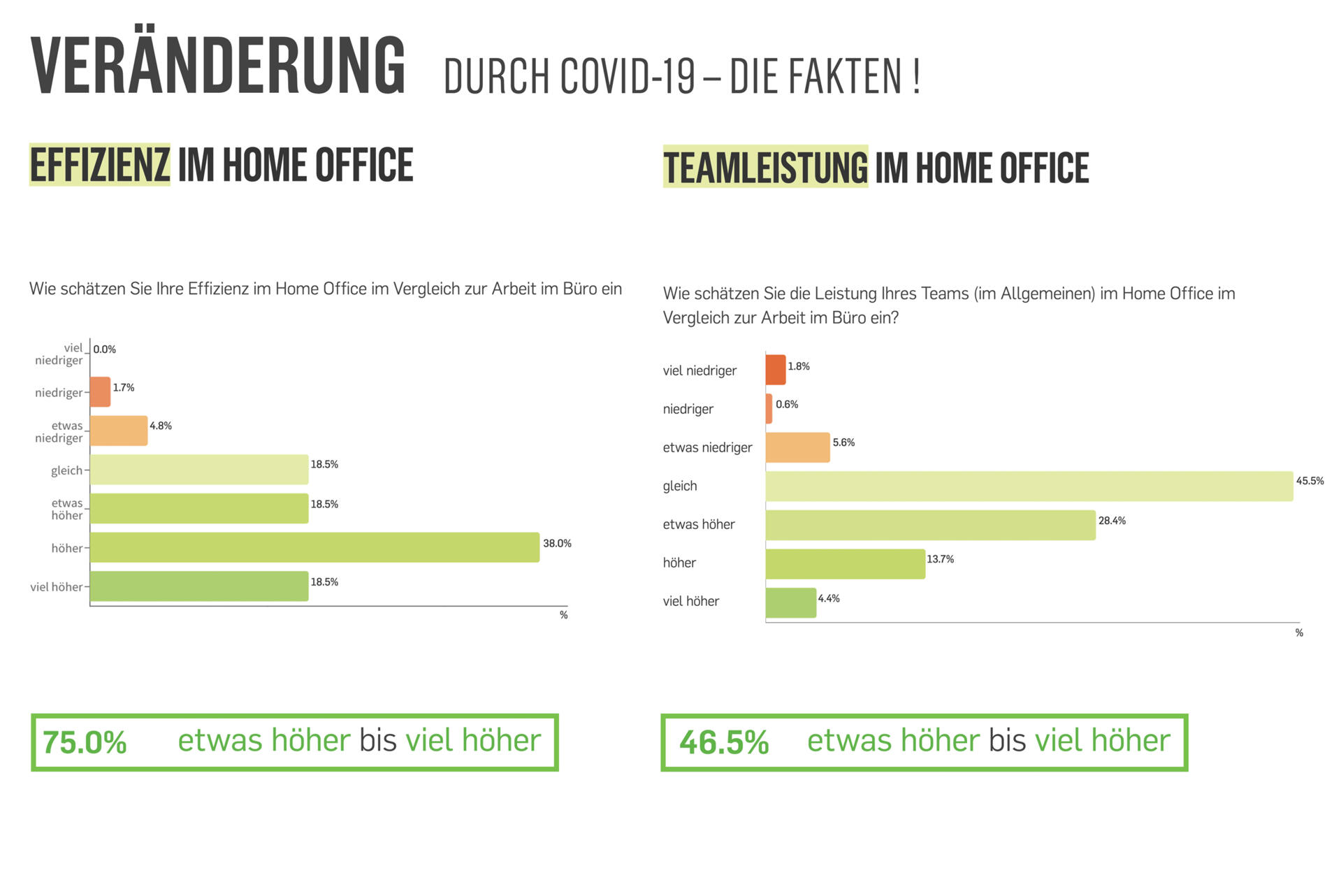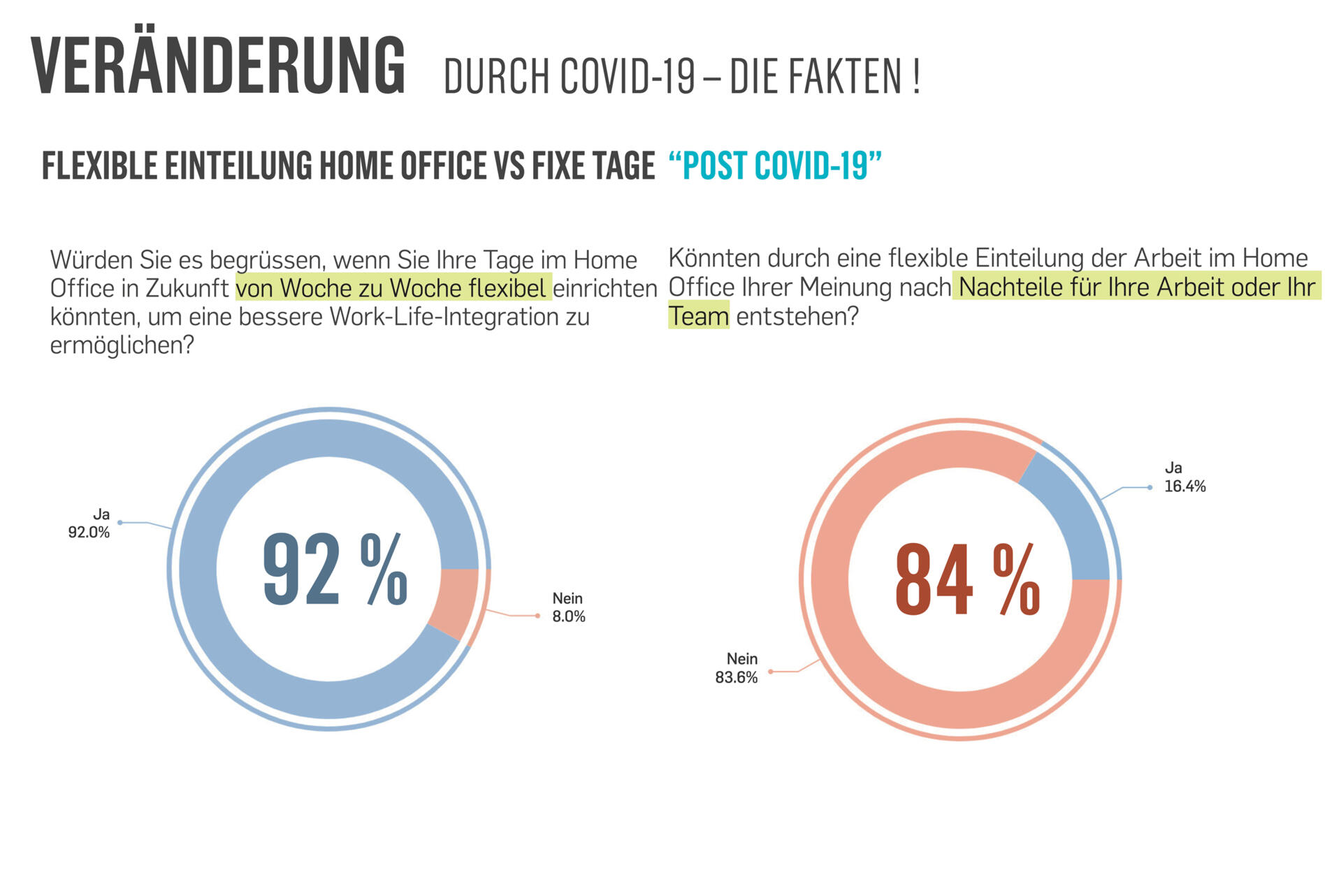The Future of Work after COVID-19
Post-pandemic workplace, user-inclusive design, research methods and healthy work environment – a conversation with Stefan Camenzind and Tanya Ruegg.
» The COVID-19 pandemic had a massive impact on our lives. How did it change the workplace culture?
Stefan: All our COVID-19 surveys that we carried out among our clients, in total approximately 6000 people, show that people enjoy the freedom and self-determination of working from home. The concept of home office or remote working is certainly here to stay. The employees see home office in a very positive light: it gave them freedom, they could organise their day more flexibly, and there was no need to commute to work. Many felt more efficient and were able to fully concentrate.
» Were people actually more efficient?
Stefan: Yes, even the employers in our surveys confirm that. At the beginning of the pandemic, to make such assessment was difficult. It could have been that the employees were over productive because they were afraid of being fired. But efficiency has actually increased over the course of the pandemic as employees have become more proficient with digital tools.
Tanya: Our surveys also revealed that most people would like to work from home for 40-60 percent of their working hours. However, people also miss their colleagues and social interaction, and they see clear benefits in being physically present for certain meetings, such as workshops and large team events. So, it means that people want to return to the office for interaction, but they will expect great spaces for working with their colleagues.
Stefan: Many have told us: we want to go back but just not all the time; we want to keep the flexibility. I emphasise this because the employees also know that this is now going to be very tricky.
» In what way tricky?
Stefan: We now have the situation where managers are saying that we have to encourage people to return to the office. Precisely those who previously claimed that working from home was not an option in their company now want to explain to us what the future will look like. These people lost their credibility in the pandemic. They were wrong. Full stop.
» Why do these managers now want people to return to how it was before the pandemic?
Stefan: For two reasons. On the one hand because of the rubber band impulse: people are always drawn back to the old ways. Preventing this is extremely difficult. And then there’s the office bias. For example, some managers continued to work in their offices during the pandemic because they couldn’t or didn’t want to work from home. Their leadership style hasn’t really changed. They are constantly in the office and run their teams from there. If you’re not in the office, you miss 80 percent of the information. As a result, even though you are allowed to work from home, you are drawn to the office because otherwise you miss out on things.
» Many companies agree for their employees to work from home, if they coordinate this with their manager.
Stefan: This attitude is the death of home office! Even before the pandemic, HR often said: “Yes, of course, working from home is basically possible, but you have to discuss this with your managers.” But the managers have learned a certain management style and thus prevent home office work.
» How so?
Stefan: Managers feel it is their job to organise things. And organisation is traditionally control. It was always like that: the office was actually always there to control people, to control their minds and to control their lives.
» You sound like someone who wants to free the workers.
Stefan: Absolutely! This claim that home office workers are getting lazy, that communication is inefficient – these were always protective claims. We’ve recently built a new headquarters for chocolate manufacturer Barry Callebaut during the pandemic – working entirely from home. The entire project team met once at the beginning of the project, after that everything ran virtually.
» But can you generalise this desire to work from home?
Stefan: Yes, that surprised us too. We did some research and found that this desire applies to all industries and sectors, and not just to creatives, the young or the hip. The flexibility, the freedom to decide for yourself when you want to work and how, goes back to a basic human need: self-determination. Many tell us in the surveys that if this flexibility is no longer available after the pandemic, they will consider changing jobs. Companies that don’t adapt will lose employees.
» What should companies do in order to retain their staff?
Tanya: From the future workplace planning point of view, it is clear that office buildings will have to provide more diverse and flexible work settings and atmospheres for people to interact and work together. Also, they certainly will have to become more attractive to entice people to return to the office.
Stefan: If companies want to motivate their people to return, they have to have a convincing answer to the question of what it’s actually good for.
» How did you actually start designing workplaces?
Stefan: Google Zurich was the first office we designed, when we started the project, we didn’t have a clue about office design. This was actually the best possible starting point as it meant we didn’t approach the design with preconceived ideas. Instead, we took a fresh look at why we need offices and what they are supposed to do for us.
Tanya: We developed a user-inclusive design process, making sure that the office foremost serves the needs of its users and that it supports them in their daily activities and in their strive for excellence. We didn’t just create a funky design but developed a unique architectural identity for Google, based on its culture, vision and values. Afterwards it became known around the world as ‘Googly design’.
Stefan: Whilst working on the Google Zurich office, we also used a technique that we know today as loop learning.
» Loop learning?
Stefan: Yes. An office project used to be done like this: you had a space allocation plan, you need that much space for so many people, you can put that in an Excel sheet, then you produce a timeline and a deadline by which everything has to be decided. And then you make the biggest decision right at the beginning: this team sits here and that team sits there. The small decisions, the fine tuning, the design, that comes at the end. We turn it around. As companies are evolving all the time and projects can take up to 2 to 5 years, it is crucial to make important decisions as late as possible. We want to design and build not for now, but for later – in 5 to 10 years’ time, and the longer we wait with decision making, the closer we are to that future. When the project is finished, it reflects exactly what the client needs and the project remains relevant for many years.
Tanya: With loop learning, we evaluate our solutions and designs and set priorities which usually leads to a larger re-evaluation. We look at the outcomes from this process and then redraw, re-analyse and readjust our initial designs to improve them.
» Why is that important?
Stefan: We had a customer who built a new factory in China, and a year later he wanted to adapt something and realised that that wasn’t possible, the factory had been planned for a single moment in time. Although they had the most efficient space allocation possible, there was actually only one short moment when it was perfect: the moment of the opening. You have to avoid that today. An office must be flexible. And with loop learning we make loops, and we make the really big decisions at the end. You might not decide which department is located where until the last day.
» How do you usually start a new project?
Stefan: We know that the design is very important. However, we have also learned over the years that data collection is crucial in order to create a truly functional environment. That means real measurements and real calculations, which we discuss with users and decision-makers, to find the most suitable functional solution to their needs. For this reason, we have developed our own research tools. Our space utilisation study helps us understand how people use the space now, whereas our workstyle analysis shows us what kind of spaces people need in order to do their job in the best possible way. We compare the present situation and model scenarios of how the workplace might change in the future. We put all this data into our workplace calculator, which helps to determine how many and what sorts of meeting rooms are required, how many desks are needed, how many phone booths should be planned, and much more. As you can see, we have a data-driven design approach. When combined with the look and feel concept, which is always based on the vision and culture of our client, it gives us the perfect combination for designing the optimal work environment.
» We have established that behind each project stands a solid base of facts and figures. But how about creativity? How do you come up with creative designs, tailored to each individual client?
Tanya: There are several ways to achieve that. The most important thing when starting any project is to rid ourselves of preconceived ideas. We start by writing down everything that comes to mind within the first 10 seconds of thinking about a new client or a new project. We also collect images, pin them on the walls, make some sketches, and write down initial keywords. We then start approaching the project from different angles, try to think out of the box, and turn our first ideas upside down.
User involvement is another crucial part of our creative journey. We ask user representatives to present their needs, ideas, images and choices, and by doing so we learn about their personal preferences, any distinct local cultural needs in international projects, along with the culture of the company. A very good example of integrating the local culture into the workplace design was our work on the Google office in Tel Aviv, where the rich Israeli culture and heritage is visualised through the orange orchards, olive groves, the romantic old town of Jaffa, and Bauhaus architecture.
» Health and well-being at workplace are growing topics. What are the keys to designing a contemporary, innovative and healthy work environment?
Tanya: We now know that one of the biggest factors in a person’s well-being is their level of stress. Stress causes a myriad of long-term health problems, so we aim to reduce stress at work by designing spaces that help people to be more focused and get things done in a positive way. We also know that there are several factors in an office environment that contribute to stress, such as leadership and culture, but there are also spatial factors, and noise is the biggest of these. If you have a deadline and there is noise around and you cannot concentrate and have nowhere to go, it can be very stressful. People can become ill from that. Therefore, reducing stress is absolutely crucial. In the post-pandemic work environment, an office has to have quiet working areas, where working without interruption and noise is guaranteed. The same goes for video calls. At home office, we became accustomed to doing our video calls without interruptions and background noise, therefore, offices have to offer audio and video call booths where such calls can be made in peace and quiet.

















